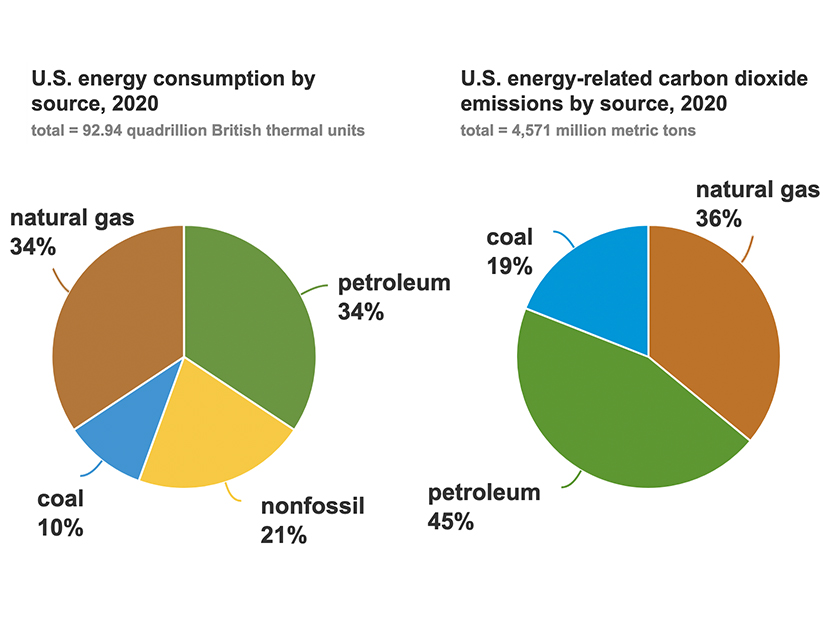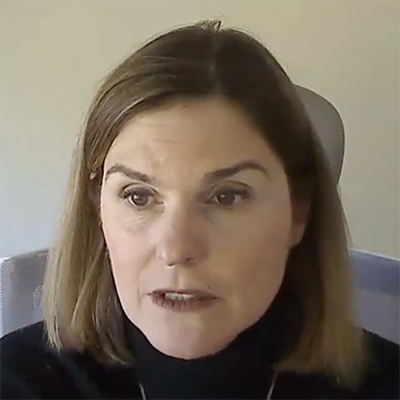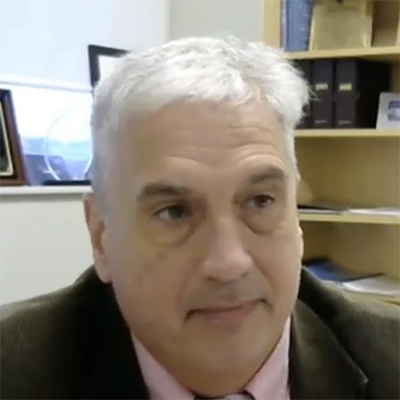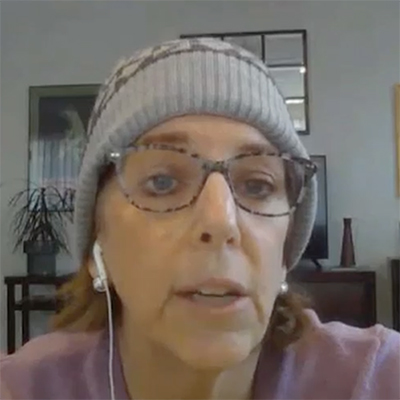
Concerns over FERC’s legal authority to mitigate greenhouse gas emissions came up throughout the commission’s technical conference on GHG mitigation Friday (PL21-3).
The first panel featured Commissioner James Danly disagreeing with FERC Chair Richard Glick on the commission’s statutory responsibilities under the Natural Gas Act and the National Environmental Policy Act.
 FERC Chairman Richard Glick | FERC
FERC Chairman Richard Glick | FERC“From my perspective, the law is very clear; the court decisions are very clear,” Glick said in summing up the day. “The D.C. Circuit [Court of Appeals] has told us that we can in fact mitigate greenhouse gas emissions; that we should in fact examine the impact of these emissions on climate change when we pursue our proceedings in terms of determining whether a pipeline is in the public interest.” (See DC Circuit Slaps FERC on Pipeline GHG Analysis.)
Danly said the NEPA analysis required is not as broad as Glick asserts it is, and any mechanism to enforce mitigation regimes would represent non-traditional employments of the commission’s powers.
“I really do believe that these legal questions are fundamental and should be determined in the first instance; they’re dispositive,” Danly said.
 FERC Commissioner Allison Clements | FERC
FERC Commissioner Allison Clements | FERCWillie Philips, newly confirmed by the Senate as the third Democratic member on the five-member commission, would give Glick’s position the majority if the issue continues to divide along party lines.
FERC Commissioner Allison Clements said the issue will be litigated “no matter what happens,” and that an important component on which the commission now has a full record is procedural: how to determine need, the order of events that take place and providing a legally durable framework.
“I would just say that the biggest issue here is certainty: certainty for stakeholders and for project developers, and I think we’ve created a lot of uncertainty over the last several years,” Glick said. “My goal is a proceeding in which we’re hopefully going to have a revised policy statement in terms of how we pursue certification of natural gas plants [and pipelines], and I’m hoping that we can get to that much sooner than later.”
 FERC Commissioner James Danly | FERC
FERC Commissioner James Danly | FERCThe debate even drew a tweet from former Commissioner Bernard McNamee on the “interesting discussion on whether FERC has the legal authority to deny a pipeline certificate based on upstream or downstream emissions,” with a link to his 2019 concurrence as to why it does not.
The only state regulator to speak at the conference, New York Public Service Commissioner Diane Burman, said that the legal jurisdictional issues are a challenge, but that the threshold issue is something that needs to be addressed because legal uncertainty is going to be a problem.
“It’s best to collaborate and be reasonable, work with the industry, and you could sit with your other federal agencies or browse state partners,” Burman said.
Compliance and Cost Recovery
Currently, FERC’s post-certificate environmental monitoring begins at project construction and ends once commission staff deem additional restoration inspections are not necessary. One panel discussed the cost impacts to the industry from implementing GHG mitigation and how project sponsors should recover those costs.
 Stephen Mayfield, City of Tallahassee | FERC
Stephen Mayfield, City of Tallahassee | FERCCost impact to consumers is consideration No. 1 in evaluating any mitigation regime, said Stephen Mayfield, director of gas operations for the city of Tallahassee, Fla., speaking on behalf of the American Public Gas Association.
Given the higher energy burden borne by low-income households, “we in Tallahassee have shown our commitment to emissions reduction by joining EPA methane challenge programs and incorporating emissions-reduction best practices into our operations,” Mayfield said.
To the extent that mitigation measures are undertaken in a market-based context, whether those costs would be recoverable really depends on whether the investments are prudent, said Carl Pechman, director of the National Regulatory Research Institute at the National Association of Regulatory Utility Commissioners.
 Carl Pechman, National Regulatory Research Institute | FERC
Carl Pechman, National Regulatory Research Institute | FERC“So the answer really depends upon the regulatory structure under which investments and operation of the gas facilities are being undertaken,” Pechman said.
If project sponsors propose to recover the cost of mitigation measures, FERC should consider factors such as timing, technology, fugitive emissions, transparency of data and project sponsors as beneficiaries of perpetuated carbon industries, said Rachel Dawn Davis, public policy and justice organizer at environmental advocacy group Waterspirit.
After Davis expressed skepticism about the capacity of carbon capture and sequestration to help reduce GHG emissions, Paula VanLaningham, global head of carbon at S&P Global Platts, said it’s premature and counterproductive to claim that it is never going to be a solution to the emissions problem.
 Paula VanLaningham, S&P Global Platts | FERC
Paula VanLaningham, S&P Global Platts | FERC“This is an area that is actively being improved and developed quite regularly now, and there are a number of different ways to do that both naturally, but then also in improved technology,” VanLaningham said.
People may be against renewable natural gas, hydrogen or carbon capture, but climate change requires an “all-hands-on-deck approach,” and the effort should be focusing as much on innovation and technology as anything, Burman said.
“It’s becoming more and more common to see operators employ gas-capturing techniques so that little or no gas needs to be purged to the atmosphere during maintenance activities,” Burman said. “The pumped-down technologies allow upwards of 90% of the gas to be captured and reinjected into the pipelines rather than admitted into the atmosphere during pipeline operations and maintenance activities.”
Mitigation Types
Finding ways to mitigate GHG emissions in proposed projects will take both technological advances and market-based approaches. Several panelists discussed current mitigation measures employed by project sponsors at facilities or by end users and future technologies.
Caitlin Tessin, director of market innovation for Enbridge (NYSE:ENB), said the company is constantly looking for ways to mitigate GHG emissions in their pipeline operations to reach their targets of a 35% reduction in their GHG footprint by 2035 and net-zero emissions from operations by 2050. Tessin said Enbridge is taking steps to reduce leaks and minimize the volume of natural gas vented during construction and maintenance by using tools like pneumatic value operators, dry seals and electric starters.
 NYPSC Commissioner Diane X. Burman | FERC
NYPSC Commissioner Diane X. Burman | FERCEnbridge utilizes a blow-down collection system process, which is designed to pull down and recompress gas that would have been vented. Some of their electric compressors used in new compression capability are powered by solar resources, Tessin said, and Enbridge currently has the only two operating behind-the-meter solar projects powering electric compressors in North America.
“There’s no one-size-fits-all solution and physical mitigation techniques,” Tessin said. “In deciding what forms of mitigation may be appropriate at a particular site, we must carefully consider a range of factors, including operational limitations to ensure reliability, commercial considerations, customer preferences, regulatory requirements, landowner interest and more.”
Anna Scott, chief science officer of Project Canary, a Denver-based energy data company, said the company has been developing continuous emissions measurement and quantification. The company believes independent measurement is needed because of discrepancies reported between “estimations from emissions factors” and the measurements that are taken.
Project Canary’s market-based solution includes the installation of continuous and real-time monitoring units that can quantify emissions and alert operators to when emissions exceed normal levels, allowing them to identify and remediate emissions immediately. Data collection allows the operators to identify the largest sources of emissions, Scott said.
“We think this is the type of technology that is not only employable today, technologically feasible and affordable, but it can even be helpful for the American energy industry,” Scott said.
Bill Donahue, manager of natural gas resources for Puget Sound Energy, said the company’s pipeline replacement programs have been instrumental in mitigation efforts, identifying the most leak-prone aspects of the system and completely replacing out-of-date cast-iron and bare steel pipes. Donahue said the company is also studying value technology to reduce methane emissions and to consider in the viability of a hydrogen blend scenario in pipelines.
Donahue said the utility is also considering market-based mitigation efforts, including platforms to certify, record and account for credits in a “broad category of carbon reduction.” He gave an example of the Midwest Renewable Energy Tracking System (M-RETS), a system that records, documents and validates efforts made to reduce emissions.
“In the event that a market has exceeded their requirements, those products can be sold to another party that does not have access to renewable gas or other technologies,” Donahue said. “So there are products out there.”

